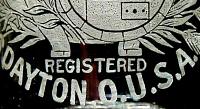 |
Figure 5a |
 |
b |
 |
c |
 |
d |
The common, "short tail" Lockbox at far left [Figure 4a] appears to be the most recent. Note that the text is a standard font with clean, straight verticals and no distinguishing characteristics. The label is notable for a barrelhead that consists of three panels, with the center piece being much wider that the two outer members. Note also the rectangular outline in 5 o’clock position on the barrelhead: it contains a line of three dots [Figure 5a]. The area below the barrel and between the prongs of the horseshoe is empty: the grain stalks that are evident to either side of the barrel do not extend into this area.
 |
Figure 5a |
 |
b |
 |
c |
 |
d |
The glass immediately to the right [Figure 4b] is a rare “short tail” Lockbox 290 variant. Although clearly a different glass, most of the distinguishing features noted in the common version are seen here also. Indeed, the main difference between this and the more common version is in the area below the barrel, where we see that it's occupied by stems of the grain stalks [Figure 5b].
The next in the series [Figure 4c] is the familiar “long tail” Lockbox. There are several significant differences between this glass and the previous two. The barrelhead now consists of six distinct panels and the three dots appearing in the rectangle at 5 o’clock appear to have been replaced by three characters [Figure 5c]. These are so small that they are almost impossible to discern, even when the etching is crisp and clear. After having put several examples under a loupe, my best guess is that they represent a small heart with a dot over it, the letter S in an old English font, and the number 9. The area below the barrel is now congested with stems and finally, note how distinctive the font used to spell out the line "Dayton.O.U.S.A." has become. The middle “O” (for Ohio) swells at its center and the entire line is sufficiently crude that it appears to have been etched free-hand. To anyone who has spent time studying George Truog’s work, this line positively reeks of the Master’s touch.
The final glass in the series [Figure 4d] is an exceptionally rare example that I’ve seen in vitro on only two occasions. In stark contrast to the other Hayner glasses described above, the label is etched on a regular shot rather than on a cylinder and both glasses that I’ve had a chance to examine have been shot through with the spider-web crazing that I associate with extreme age. There are very subtle variations in design between this and the previous glass, but the handiwork on this glass is even more strongly reminiscent of Truog (note the number 2 on the upper line for example: it would look completely at home on one of his Victor Liver Syrup glasses). But there is no tell-tale GT signature.
This interesting story would have ended here were it not for a glass that I recently encountered among Ken Schwartz’ collection [Figure 6].
 |
| Figure 6 Photograph courtesy of and copyright Ken Schwartz, 2006 |
It's not a Hayner, but it is another uncommon cylinder glass. The label advertises Cabinet Bourbon supplied by Geo Buente Shipping Co., origins unknown (now known to be a St. Louis, MO company: Ed.) . The resemblance between the horseshoe-and-barrel-with-grain-stalks design on this glass is obvious even to an untrained eye, even though the details of the barrel head seen on Hayner glasses is lacking here. Most importantly, however, this glass was designed and signed by George Truog: a tiny transparent GT appears on the right-hand prong of the horseshoe below the barrel.
Although evidence is circumstantial at best, we might speculate that the design that Truog created for Buente Shipping was recycled with minor modification for the Hayner Lockbox 290, and later, with further tweaking, for the Hayner Distilling glass at the head of our Top 10 list. The converse is equally possible - that the original design was for Hayner and that it was this that was modified for use on the Buente cylinder. Regardless, it is probably significant that the Hayner family had registered the distinctive horseshoe-barrel-grain-stalks design as a trademark and was using it on company letterheads in 1894 and probably earlier [Figure 7]. Truog established his Maryland Glass Etching Works in 1893 but had been designing glasses for other glass houses since 1883 (Murschell 2002, 2004). We have no further information about Buente Shipping Co., but see the inset on the next page [Figures 8 & 9] for more on the suggested link between Truog, cylinder glasses, and the horseshoe-barrel-grain-stalk design.
 |
| Figure 7. The classic horseshoe-barrel-grain-stalk design on a Hayner billhead dated 1894. |
We'll re-visit the Top 10 list in some future edition on Random Shots because there are other stories here worth telling. Meanwhile, don't be so quick to hit the your browser's "back" button when that eBay listing with a heading "MINT, etched pre-Pro shot glass, VERY RARE, NO RESERVE!!" features a Hayner cylinder. It might very well be rare glass after all.
Robin is an enthusiastic collector of shot glasses and maintains the collector’s website www.pre-pro.com. He can be reached at 245 N 15th St., MS#488, Philadelphia, PA 19102, e-mail oldwhiskey@pre-pro.com.
References:
Murschell, D. (2002)
Glass of Cumberland Maryland Area; self published
Murschell, D. (2004)
George Truog and His Art; self published
[ Turn Back a Page ] [ Back to Random Shots Index ] [ Turn to Next Page ]